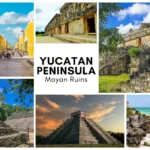Welcome to the heart of Latin America, where the vibrant spirit of Mexico awaits to unfold its many wonders. As we journey through 2024, Mexico continues to enchant the world with its rich tapestry of history, culture, and breathtaking diversity. From the echoes of ancient civilizations to the pulsating rhythms of modern life, Mexico offers a kaleidoscope of experiences that transcend time and space. Prepare to be surprised, delighted, and deeply moved as we explore the lesser-known yet cool facts about Mexico.
But before you continue reading, be prepared to fall in love and get excited to explore Mexico! As you plan your trip, H2OH is here to make your plans into a reality with our private yacht charter Mexico service!
Let’s explore some Mexico fun facts!
History and Culture
1. Ancient Civilizations
Mexico’s rich history is intricately woven with the legacies of the Aztecs and Mayas, two of the most advanced civilizations of their time. These societies were not only master builders, creating monumental pyramids and cities like Teotihuacan, Chichen Itza, and Tenochtitlan, but also astute astronomers. Their understanding of celestial bodies was so precise that their calendars are still admired for their accuracy. The Aztecs and Mayas left behind a wealth of knowledge in their art, architecture, and complex social and political systems, which continue to captivate the world. Their achievements are a testament to the ingenuity and sophistication of pre-Columbian societies in Mexico.
2. A Melting Pot of Cultures
The arrival of the Spanish in the 16th century initiated a profound cultural fusion, blending Indigenous traditions with European influences. This amalgamation gave birth to a unique cultural identity that defines modern Mexico. The Spanish language, infused with indigenous words, is just one example of this blend. Mexican customs and traditions also reflect this fusion, from the colorful Day of the Dead celebrations, which combine Catholic and indigenous beliefs, to the vibrant folk art and handicrafts that merge pre-Columbian and Spanish artistic techniques. This cultural tapestry is what makes Mexico distinct, offering a rich, multi-layered experience that is both historical and contemporary.
Geography and Nature
3. Biodiversity Hotspot
Mexico stands as one of the world’s most significant biodiversity hotspots. It boasts an astonishing variety of ecosystems, from rainforests and deserts to mountains and coastal areas, hosting over 200,000 different species. Remarkably, many of these species are endemic, found nowhere else on Earth. This diversity includes a wide array of plants, mammals, reptiles, amphibians, and birds, making Mexico a crucial area for conservation efforts and a paradise for biologists and nature enthusiasts alike. The country’s commitment to preserving its natural heritage is evident in its numerous protected areas and national parks.
4. Majestic Landscapes
The geographical diversity of Mexico offers a stunning array of landscapes. The northern regions are characterized by expansive deserts and rugged mountains, while the southern parts are dominated by lush rainforests and tropical beaches. This varied topography not only makes Mexico a visually stunning place but also contributes to the rich biodiversity. From the copper canyons in the north to the crystal-clear cenotes of the Yucatan Peninsula, each landscape tells a story of geological history and natural beauty.
Culinary Delights
5. More than Just Tacos
Mexican cuisine, recognized by UNESCO as an Intangible Cultural Heritage, is a delightful culinary journey beyond the widely known tacos and burritos. Each region in Mexico offers its unique specialties, deeply rooted in local traditions and ingredients. From the seafood dishes of the coastal areas to the hearty stews and meats of the inland regions, Mexican cuisine is a complex blend of flavors and techniques. Dishes like mole, pozole, and tamales showcase the depth and variety of this cuisine, each with a story and flavor profile that is distinctly Mexican.
6. A World of Spices
The diversity of Mexican cuisine is largely attributed to its use of a wide range of spices, herbs, and chilies. These ingredients, integral to Mexican cooking, add not just heat but depth and complexity to the dishes. Chilies like jalapeño, poblano, and habanero, each with their distinct flavor profiles, are used creatively in sauces, salsas, and marinades. Herbs like cilantro, epazote, and Mexican oregano add freshness and aromatic nuances, while spices such as cumin and cinnamon introduce warmth and richness. This masterful use of spices and herbs is what makes Mexican cuisine vibrant and uniquely flavorful.
Music and Entertainment
7. Rich Musical Heritage
Mexican music is a vibrant tapestry woven from diverse cultural threads. The iconic Mariachi bands, with their spirited performances, are perhaps the most globally recognized symbol of Mexican music. Originating in the 18th century, Mariachi music combines string instruments, trumpets, and powerful vocals, often evoking passionate responses from its audience. Banda, another popular genre, infuses traditional Mexican sounds with military band influences, resulting in a lively and rhythmic experience. These musical styles are not just entertainment; they are a reflection of Mexico’s complex history, blending Indigenous, African, and Spanish influences to create a musical landscape that is both rich and uniquely Mexican.
8. Cinema Renaissance
By 2024, Mexico continues to solidify its place as a film industry leader. Building on a tradition that dates back to the Golden Age of Mexican Cinema in the mid-20th century, contemporary Mexican directors and actors have gained acclaim on international platforms. Mexican cinema is known for its poignant storytelling, often exploring social and political themes relevant to both Mexican and global audiences. This renaissance has brought forward a new generation of filmmakers who are not afraid to experiment and push boundaries, placing Mexico firmly on the global cinematic map.
Festivals and Celebrations
9. Day of the Dead
The Day of the Dead, or Día de Muertos, is a quintessentially Mexican festival celebrated at the beginning of November. This festival is a time when families honor their deceased loved ones in a manner that is both solemn and celebratory. Altars (ofrendas) are adorned with marigolds, candles, food, and items cherished by the departed. Far from being a morbid event, it’s a colorful expression of the Mexican philosophy that views death as a natural part of life’s continuum. This festival, a UNESCO Intangible Cultural Heritage, encapsulates the Mexican cultural attitude towards death, blending respect, love, and joy.
10. Vibrant New Celebrations
In 2024, Mexico’s festival scene is infused with innovation, reflecting the country’s dynamic spirit. New festivals have emerged that blend traditional arts with contemporary digital technologies. These festivals showcase installations, performances, and exhibitions that merge art and technology, creating immersive experiences for attendees. These events not only celebrate Mexican creativity but also signal the country’s embrace of the digital age, making traditional cultural expressions more accessible and engaging to a broader, more technologically savvy audience.
Art and Architecture
11. Pre-Columbian and Colonial Legacy
Mexican art and architecture carry the legacies of both its pre-Columbian past and colonial history. Ancient civilizations like the Maya and Aztec left behind grand pyramids, temples, and cities that continue to inspire awe. Post-conquest, the Spanish colonial era introduced baroque and neoclassical architectural styles, resulting in a unique blend evident in Mexico’s cathedrals, public buildings, and homes. This mix of indigenous and European influences has created a distinctive aesthetic that is visible across Mexican cities and has profoundly influenced Mexican artistic traditions.
12. Modern Art Movement
The contemporary art scene in Mexico is as vibrant and diverse as its history. Mexican artists have gained international recognition for their innovative and thought-provoking work. Drawing on a rich cultural heritage, these artists explore themes ranging from identity and social justice to the surreal and fantastical. Galleries, both large and small, across cities like Mexico City, Guadalajara, and Monterrey, are spaces where this creative energy is palpable, highlighting Mexico’s role as a significant player in the global art scene.
Economic Growth and Innovation
13. Economic Resilience
Despite facing global economic challenges, Mexico’s economy in 2024 shows remarkable resilience and growth. This growth is largely driven by its strong manufacturing sector, technological advancements, and a booming tourism industry. Mexico’s strategic geographical location, paired with its extensive trade agreements, positions it as a key player in international trade, particularly in industries like automobile manufacturing and electronics.
14. Hub for Startups
Mexico has become a burgeoning hub for startups, particularly in the fields of fintech, e-commerce, and green technology. The startup ecosystem is fueled by a combination of governmental support, venture capital investment, and a growing pool of tech-savvy entrepreneurs. These startups are not only contributing to the country’s economic growth but are also addressing social and environmental challenges, reflecting Mexico’s commitment to innovation and sustainability.
Tourism and Attractions
15. Unexplored Destinations
Beyond the well-trodden paths of Cancun and Mexico City, Mexico is home to a plethora of lesser-known destinations that offer rich, authentic cultural experiences. Cities like Puebla and Guanajuato are jewels waiting to be discovered. Puebla, known for its stunning colonial architecture and culinary delights like mole poblano, offers a unique blend of indigenous and Spanish cultural influences. Guanajuato, with its colorful streets, rich mining history, and the famous Festival Cervantino, is a hub for arts and culture. These destinations provide a deeper understanding of Mexico’s diverse heritage and offer a more intimate look into the country’s soul. You can easily reach here by booking a Cancun boat rental by H2OH.
Way Forward
As our exploration of Mexico’s interesting facts to a close, we are left with a profound appreciation for this country’s incredible journey through time. Mexico’s vibrant culture, resilient spirit, and dynamic innovations paint a picture of a nation that is constantly evolving, yet deeply rooted in its rich heritage. The stories and facts we’ve uncovered are but a glimpse into the soul of Mexico – a country that continually surprises and inspires. Whether through its colorful festivals, innovative strides, or the warmth of its people, Mexico truly represents the beauty and strength found in diversity and change.
So as we have explored some interesting facts about Mexico, you surely must be excited to see and experience for yourself all that Mexico has to offer. Reach out to us at H2OH and book a Tulum boat charter service to explore the rich culture of Mexico!








